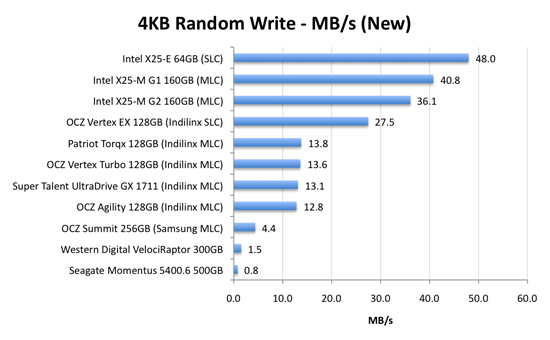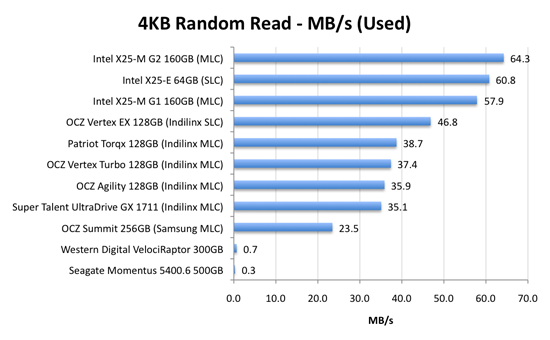The SSD Relapse: Understanding and Choosing the Best SSD
by Anand Lal Shimpi on August 30, 2009 12:00 AM EST- Posted in
- Storage
Random Read/Write Speed
This test writes 4KB in a completely random pattern over an 8GB space of the drive to simulate the sort of random writes that you'd see on an OS drive (even this is more stressful than a normal desktop user would see). I perform three concurrent IOs and run the test for 3 minutes. The results reported are in average MB/s over the entire time:

As we established in previous articles, the disk operations that feel the slowest are the random small file reads and writes. Both of which are easily handled by an SSD. A good friend of mine and former AnandTech Editor, Matthew Witheiler, asked me if he'd notice the performance improvement. I showed him the chart above.
He asked again if he'd notice. I said, emphatically, yes.

Now this is super interesting. Intel's X25-M G1 drops from 40.8MB/s when new down to 26.3MB/s in a well used state. Unfortunately for the G1, it will never get TRIM and will spend more time in the lower performance state over the life of the drive. But look at what happens with the X25-M G2: it drops from 36.1MB/s to 35.8MB/s - virtually no performance is lost. In fact, the G2 is so fast here that it outperforms the super expensive X25-E. Granted you don't get the lifespan of the X25-E and the SLC drive should perform better on more strenuous random write tests, but this is a major improvement.
The explanation? It actually boils down to the amount of memory on the drive. The X25-M G1 had 16MB of 166MHz SDRAM on-board, the G2 upped it to 32MB of slower 133MHz DRAM. Remember that Intel doesn't keep any user data in DRAM, it's only used for the remapping, defragmenting and tracking of all of the data being written to the drive. More DRAM means that the drive can now track more data, which means that even in the heaviest of random-write workloads you could toss at it on a normal desktop you will not actually lose any performance with the drive in a used state. And this is the drive Intel has decided to grant TRIM to.
The G2 is good.
The Indilinx drives do lose performance here. They drop from roughly 13MB/s down to 7MB/s. We're still talking ~5x the speed of a VelociRaptor, so there's no cause for alarm. But it's clear that even Indilinx's SLC drive can't match Intel's random write performance. And from what I hear, Intel's performance is only going to get better.
This is what the X25-M price premium gets you.

Bahahaha, look at the hard drive scores here: 0.7MB/s and 0.3MB/s? That's freakin' terrible! And that's why your system feels so slow when you start it up, there are a ton of concurrent random reads and writes happening all over the place which your hard drive crunches through at roughly 0.5MB/s. Even the Samsung based OCZ Summit manages a significant performance advantage here.
The Indilinx drives all cluster around the 30 - 40MB/s mark for random read performance, nothing to be ashamed of. The Intel drives kick it up a notch and give you roughly 60MB/s of random read performance. It's a noticeable improvement. As our application launch tests will show however, loading a single app on either an Indilinx or Intel drive will take about the same amount of time. It's only in the heavy multitasking and "seat of the pants" feel that you'll have a chance at feeling a difference.










295 Comments
View All Comments
Anand Lal Shimpi - Monday, August 31, 2009 - link
I believe OCZ cut prices to distributors that day, but the retail prices will take time to fall. Once you see X25-M G2s in stock then I'd expect to see the Indilinx drives fall in price. Resellers won't give you a break unless they have to :)Take care,
Anand
bobjones32 - Monday, August 31, 2009 - link
Another great AnandTech article, thanks for the read.Just a head's-up on the 80GB X-25m Gen2 - A day before Newegg finally had them on sale, they bumped their price listing from $230 to $250. They sold at $250 for about 2 hours last Friday, went back out of stock until next week, and bumped the price again from $250 to $280.
So....plain supply vs. demand is driving the price of the G2 roughly $50 higher than it was listed at a week ago. I have a feeling that if you wait a week or two, or shop around a bit, you'll easily find them selling elsewhere for the $230 price they were originally going for.
AbRASiON - Monday, August 31, 2009 - link
Correct, Newegg has gouged the 80gb from 229 to 279 and the 160gb from 449 to 499 :(Stan Zaske - Monday, August 31, 2009 - link
Absolutely first rate article Anand and I thoroughly enjoyed reading it. Get some rest dude! LOLJaramin - Monday, August 31, 2009 - link
I'm wondering, if I were to use a low capacity SSD to install my OS on, but install my programs to a HDD for space reasons, just how much would that spoil the SSD advantage? All OS reads an writes would still be on the SSD, and the paging file would also be there. I'm very curious about the amount of degradation one would see relative to different use routines and apps.Anand Lal Shimpi - Monday, August 31, 2009 - link
Putting all of your apps (especially frequently used ones) off of your SSD would defeat the purpose of an SSD. You'd be missing out on the ultra-fast app launch times.Pick a good SSD and you won't have to worry too much about performance degradation. As long as you don't stick it into a database server :)
Take care,
Anand
swedishchef - Tuesday, September 1, 2009 - link
What if you just put your photoshop cache on a pair of Velociraptors? Would it be the same loss of benefit?I have the same question regarding uncompressed HD video work, where I need write speeds well over the Intel x25-m ( over 240Mb/s). My assumption would be that I could enjoy the fast IO and App. launch of an SSD and increase CPU performance with the SSD while keeping the files on a fast external or internal raid configuration.
Thank you again for a a brilliant Article Anand.
I have been waiting for it for a long time. Yours are the only calm words out on the net.
Grateful Geek /Also professional image creator.
creathir - Monday, August 31, 2009 - link
Great article Anand. I've been waiting for it...My only thoughts are, why can't Intel get their act together with the sequential business? Why can the others handle it, but they can't? To have such an awesome piece of hardware have such a nasty blemish is strange to me, especially on a Gen-2 product.
I suppose there is some technical reason as to why, but it needs to be addressed.
- Creathir
Anand Lal Shimpi - Monday, August 31, 2009 - link
If Intel would only let me do a deep dive on their controller I'd be able to tell you :) There's more I'd like to say but I can't yet unfortunately.Take care,
Anand
shotage - Monday, August 31, 2009 - link
Awesome article!I'm intrigued with the cap on the sequential reads that Intel has on the G2 drives as well. I always thought it was strange to see even on their first gen stuff.
I'm assuming that this cap might be in place to somehow ensure the excellent performance they are giving with random read/writes. All until TRIM finally shows up and you'll have to write up another full on review (which I eagerly await!).
I can't wait to see what 2010 brings to the table. What with the next version of SATA and TRIM just over the horizon, I could finally get the kind of performance out of my PC that I want!!